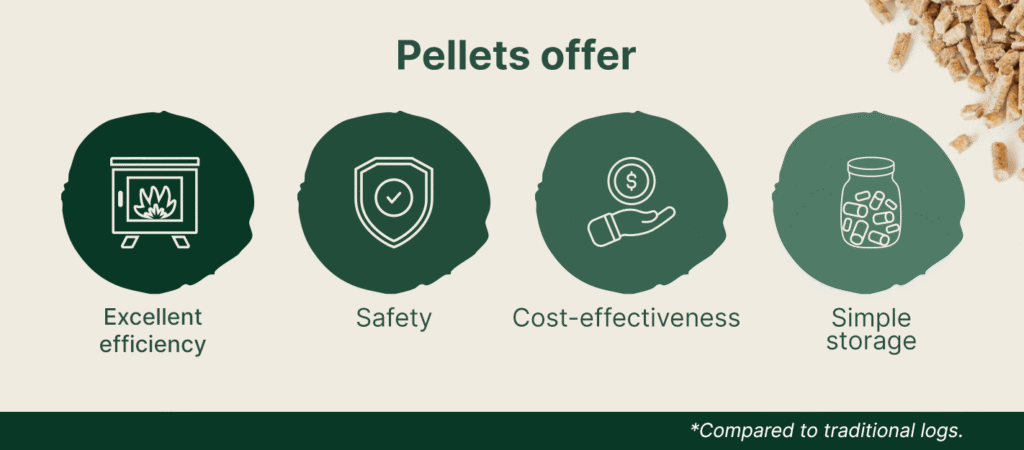Important Precautions When Using Heating Pellets
Pellet stoves are a reliable and efficient way to heat your home, but just like any heating appliance, they work …
07.29.2025
2 minute read

When it comes to home heating options, many homeowners consider alternative ways to stay warm and reduce heating expenses. Among the most popular choices are wood-burning and pellet stoves. Both provide a renewable and eco-friendly heating source without relying on costly propane gas.
Understanding your options and being well-informed is important before choosing a wood stove or pellet stove. We'll walk you through the essential differences between pellet and wood stoves, including their key features and stove costs, fuel prices, heating efficiency and safety in this guide. We'll also compare differences in installation requirements, maintenance and durability to help you determine which heating solution works best for your needs.
Wood-burning and pellet stoves differ mainly in their fuel source and how they generate heat. Wood stoves require firewood for fuel. They rely on natural airflow and manual wood fire management to maintain burning and comfortable heating.
Pellet stoves are fueled by compressed heating pellets made of upcycled wood waste from lumber mills. These pellets are placed in a hopper, where the stove automatically feeds them into the combustion chamber. This modern feature maintains consistent and comfortable heating for your home.
Here is a closer look at other factors that set wood-burning and pellet stoves apart.
The cost of wood or pellet stoves with installation falls within a similar range. The price depends on different factors, such as the type of wood or pellet stove, unit size and the complexity of installation. Whether you choose a wood stove or pellet stove, the Department of Energy states the importance of a properly sized unit for adequate space heating.
A larger wood-burning model with a more durable material is typically priced higher. You can save on the added installation for a ventilation system if your home has an existing fireplace or chimney. Choosing a non-catalytic stove is usually less expensive than a catalytic or hybrid wood-burning option. The average installation cost for a wood stove is $3,000 in 2025.
Pellet stoves are slightly more affordable, with prices increasing depending on the size and type of unit. Traditional freestanding, wall and window-mounted pellet stoves are usually more affordable than insert-type pellet stoves. They enable homeowners to avoid chimney installation costs by ventilating through a window or a hole in the wall. The average pellet stove installation cost is $2,319 as of 2024.
Fuel prices for pellet stoves vs. wood stoves can vary significantly due to various factors. Homeowners with wood-burning stoves can obtain firewood from their property, which is free. You can salvage firewood from tree removal services or buy from local suppliers if you do not have trees on your property. Firewood prices from local dealers depend on your location.
You can also get firewood from U.S. National Forests for personal use. Most U.S. National Forests require a permit before cutting firewood, which has specific criteria and associated fees during cutting season. Remember to allot adequate indoor or outdoor storage — firewood can take up significant space.
Pellet stoves require heating pellets, which are usually available in 40-pound packs. This is generally enough to provide heating for an entire day. According to the U.S. Energy Information Administration, a ton of wood pellets cost $300-$500, or six dollars to $10 per 40-pound bag. They are widely available through local suppliers and large retailers. Homeowners must store heating pellets in dry, indoor storage or airtight containers. Keeping moisture away prevents them from breaking apart and becoming unusable.
Energy use differs significantly between wood-burning vs. pellet stoves. Wood stoves operate independently and heat homes even during power outages. Pellet stoves rely entirely on electricity and require a backup system, such as a generator, to sustain heating during power outages.
The Environmental Protection Agency (EPA) recognizes that pellet stoves are generally more energy-efficient than wood stoves. Pellet stoves burn cleaner, producing less ash and smoke. They also produce less creosote buildup, which can cause chimney fires. Pellet stoves are typically safer than wood stoves because they contain burning flames. Wood stoves pose the risk of flying sparks that can lead to dangerous fires.
When comparing pellet and wood stove maintenance, wood stoves generally require more frequent upkeep. They need regular chimney sweep services and inspections to remove soot buildup and ensure safe and efficient heating. Consider this maintenance requirement on top of manually feeding the woodfire to your stove. Wood stoves usually last longer than pellet stoves. This is because they have fewer components and don't rely on electricity.
Pellet stoves also require regular cleaning and ash removal, though they generate less ash. Leftover pellets should be removed from the hopper every season to prevent tarnish inside the unit. Flue vents should also be cleaned to clear out accumulated sediments. Between a wood stove or pellet stove, pellet stoves are less taxing to clean. Wood stoves can leave behind wood chips and more soot buildup.
Pellet stoves have electrical components like fans and motors that need frequent maintenance checks and service. This means they can have issues over the years, such as unusual noise or pellet-feeding glitches.

Pellet stoves have a clear advantage over wood stove options. Pellets offer excellent efficiency, safety, cost-effectiveness and simple storage compared to traditional logs.
Consider the following factors to ensure you get high-quality, efficient pellet heating:
Wood pellet heating is an ideal option for warming your home or business with greater peace of mind.
If you're searching for top-rated heating pellets, explore our variety of the finest, cost-effective pellet brands. Discover where to buy the best pellets for your stove today!
